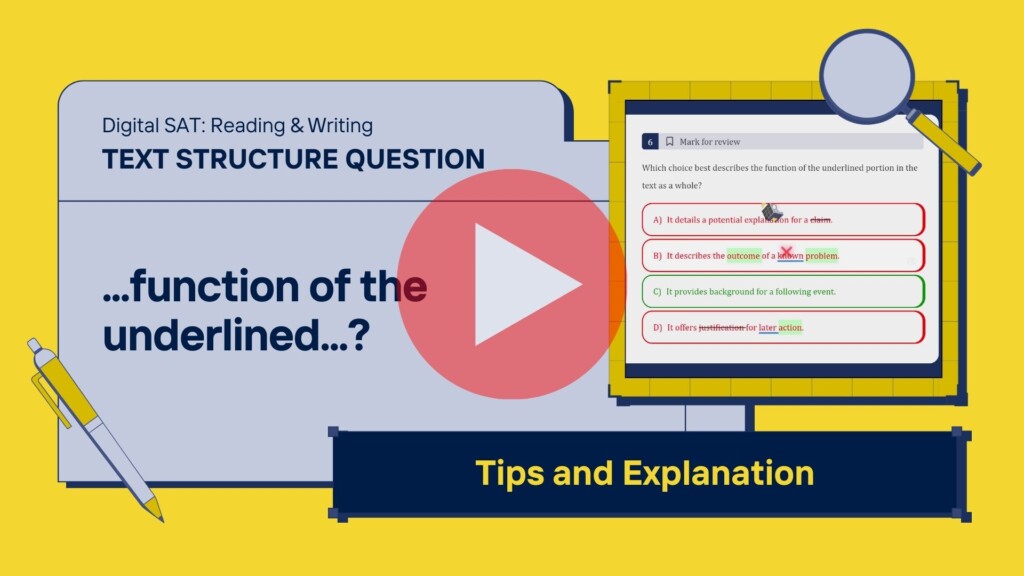The questions with an underlined sentence in Digital SAT (DSAT) English are specifically about structure. You’re not just identifying what the author says; you’re identifying why the author chose to include that specific sentence at that specific point. So let’s break down the step-by-step strategies using a sample passage. By the end, you’ll have a reliable method to determine the function of any underlined portion, no matter how subtle it may seem.
1. “Function”
Before diving into strategies, let’s clarify what the SAT means by “function”:
- Function = Purpose: You need to figure out why the author included this sentence. Is it providing background information? Offering evidence? Explaining a consequence?
- Context: A sentence’s function often depends on its context—what comes before it and what comes after it.
- Answer Choices Are Labels: The SAT will typically label functions using categorical terms such as “provides an explanation,” “serves as a transition,” “offers justification,” or “gives background.” Your job is to match the underlined sentence to the best label.
2. Sentence Relation
Whenever you see an underlined sentence, resist the temptation to jump straight to answer choices. Instead:
- Read the Sentence Itself
- Identify its content at a glance. What is it literally saying? In our example, the underlined sentence describes that the hibiscus “went extinct in the 1910s.”
- Identify Neighboring Sentences
- Look at the sentence before and the sentence after. How do they relate? In our sample:
- The first sentence introduces the hibiscus species and where it used to grow.
- The second (underlined) sentence explains that it “went extinct in the 1910s.”
- The third sentence jumps forward to “In 2019, scientists recreated its scent.”
- Look at the sentence before and the sentence after. How do they relate? In our sample:
- Consciously Group Them
- Notice that the first and underlined sentences together explain what happened to the plant: introduction + extinction.
- The third sentence refers to a future event: the recreation of its scent.
- In effect, the underlined sentence is sitting between an introductory context and a subsequent event.
3. Sentence Connection
A powerful trick is to ask yourself two simple questions:
- “What information does this sentence provide about what came before?”
- In the example, it completes the historical narrative: we know where the plant grew, and now we learn it went extinct.
- “Why is this relevant to what comes next?”
- If the plant hadn’t gone extinct, there would be no need to recreate its scent in 2019. Thus, the extinction sets up the significance of the later scientific effort.
By framing it this way, you can see that the underlined sentence functions as background—it explains the condition that motivates the next event.
4. Evaluate Labels
SAT answer choices tend to use standardized labels. Here are four choice from the sample question.
- “Details a potential explanation for a claim.”
- Looks appealing if the sentence explains “why the plant went extinct,” but our underlined part is simply factual, not a debated claim.
- “Describes the outcome of a known problem.”
- Could seem close, since extinction is the outcome. However, the “problem” (the reason it went extinct) is not stated before the underlined sentence. Instead, the problem and outcome are both in the same sentence, so it is not a “known” problem.
- “Provides background for a following event.”
- Exactly what happens here. The following event is the 2019 scent recreation. Without the background that the plant went extinct, the 2019 effort would make little sense.
- “Offers justification for a later action.”
- Similar to background, but “justification” implies a stronger causal link or rationale. In this case, the sentence doesn’t explain why scientists felt compelled to recreate the scent—only that the plant had disappeared.
Conclusion
By consistently comparing sentences, summarizing their roles, and mapping those roles onto answer choices, you’ll be able to identify the most accurate label. Remember that the underlined sentence is rarely isolated—it always exists to serve a larger purpose in the author’s narrative or argument. With this strategy in hand, you’ll be well equipped to tackle any underlined sentence questions on Digital SAT English.
Did you know we have FREE SAT English questions and weakness analysis?
In fact, this very question is from our Free SAT Reading & Writing Quiz. Analyze your skills in Reading & Writing, and discover your study focus. Complete the free questions and receive a full report of your strengths and weaknesses.
#satengtips #digitalsat #sat #dsat #satprep #sattips #sathacks #satstrategies #satenglish #satreading

